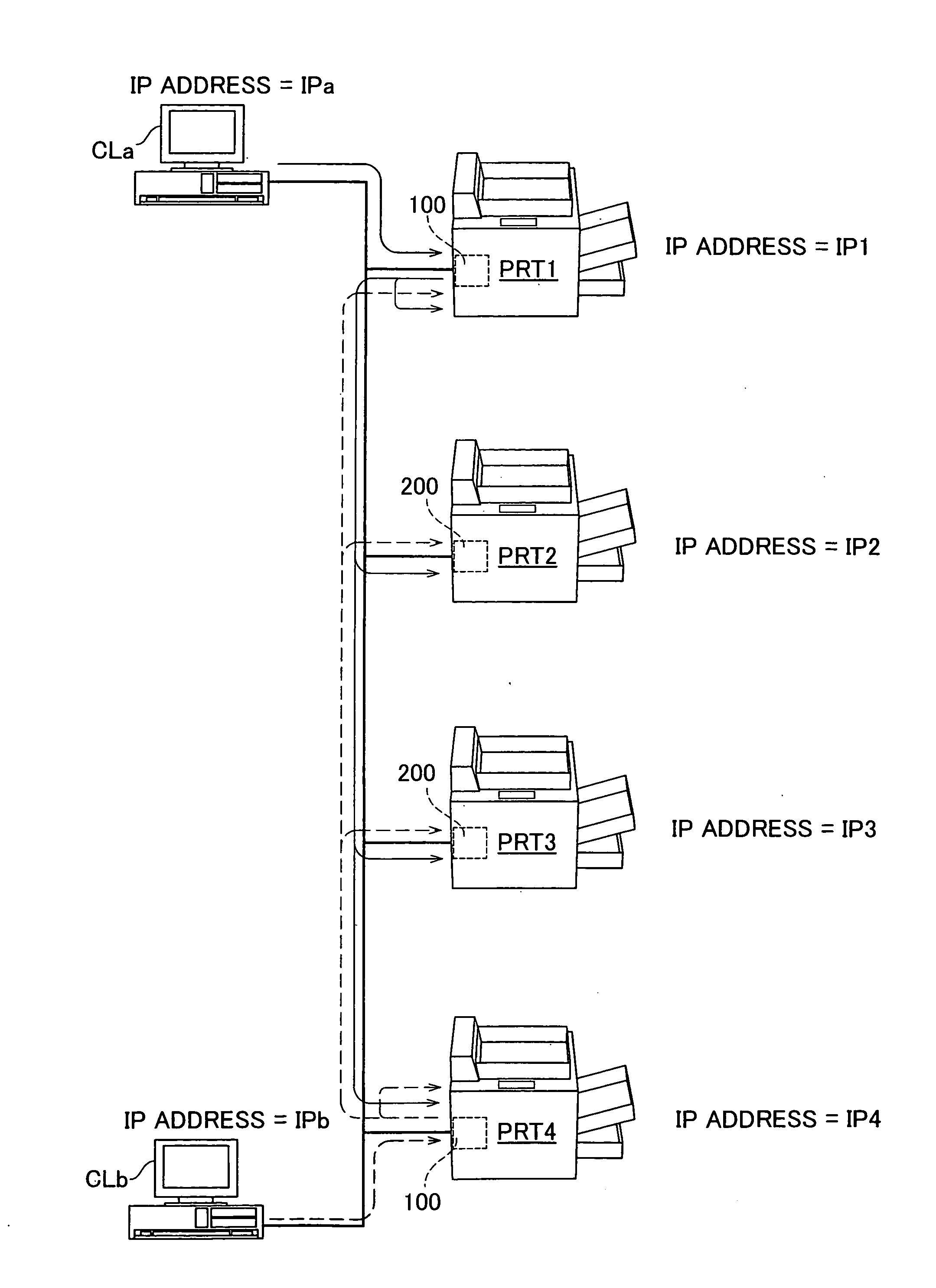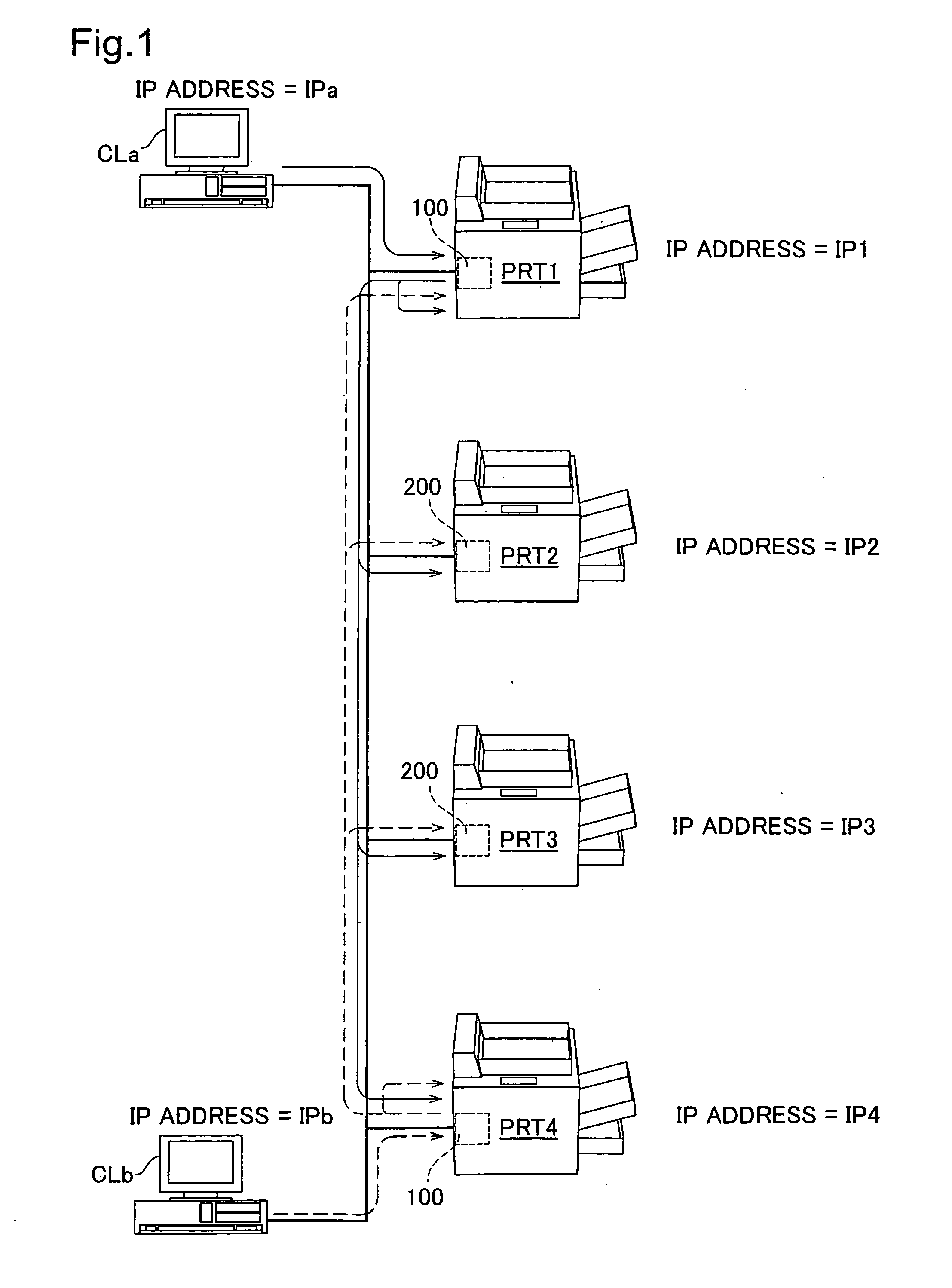Control technology used in distributed printing for printing control device and printer
a control technology and printing control technology, applied in the direction of digital output to print units, instruments, visual presentations, etc., can solve the problems of deadlock, stoppage of printing process, and interference of destination printers with the smooth execution of distributed printing, and achieve smooth distribution printing process
- Summary
- Abstract
- Description
- Claims
- Application Information
AI Technical Summary
Benefits of technology
Problems solved by technology
Method used
Image
Examples
first embodiment
A.
[0046] Structure of a Distributed Printing System:
[0047] A configuration of a distributed printing system according to a first embodiment according to the present invention will be described referencing FIG. 1 and FIG. 2. FIG. 1 schematically shows a configuration of a distributed printing system according to a first embodiment. FIG. 2 shows a block diagram of the internal structure of each device in a distributed printing system according to the first embodiment.
[0048] This distributed printing system, as shown in FIG. 1, includes a plurality of computers as clients (hereinafter termed simply “client”) CLa and CLb, and a plurality of printers PRT1 through PRT4. The clients CLa and CLb are connected via a local area network (LAN) to printers PRT1 through PRT4. Communications between each of the devices is performed using the TCP-IP protocol, and this IP addresses are assigned to each of the devices. For convenience in explanation, it is here assumed that the IP addresses assigne...
second embodiment
B. Second embodiment
[0143] Structure of a Distributed Printing System
[0144] A configuration of a distributed printing system according to a second embodiment is the same as the configuration in the first embodiment, which was described in reference to FIG. 1, and thus the explanation thereof will be omitted. FIG. 13 shows a block diagram of the internal structures of each device in a distributed printing system according to a second embodiment.
[0145] When compared to the printer PRT1 in the first embodiment, the printer PRT1 in the second embodiment differs in that the configuration of the distribution control module 50 and the print job receiving module 60 within the custom network board 100. The distribution control module 50 in the second embodiment has an exclusive use request module 543 instead of the command sending module 541 in the first embodiment, and a notification receiving module 544 instead of the response receiving module 542. The exclusive use request module 543 se...
third embodiment
D. Third embodiment
[0191] Structure of the Distributed Printing System
[0192] A configuration of a distributed printing system according to a third embodiment will be described in reference to FIG. 21 and FIG. 22. FIG. 21 schematically shows the configuration of a distributed printing system according to a third embodiment. FIG. 22 shows a block diagram of the internal structure of each device that structures a distributed printing system according to the third embodiment.
[0193] The distributed printing system in the third embodiment, as shown in FIG. 21, includes separate printers PRTa1 through PRTa4, instead of printers PRT1 through PRT4 in the distributed printing system according to the first embodiment (FIG. 1). Other configuration for the distributed printing system in the third embodiment are the same as configuration in the distributed printing system in the first example embodiment, and so the same codes are assigned in FIG. 21 and FIG. 22 for components that are identical...
PUM
 Login to View More
Login to View More Abstract
Description
Claims
Application Information
 Login to View More
Login to View More - R&D
- Intellectual Property
- Life Sciences
- Materials
- Tech Scout
- Unparalleled Data Quality
- Higher Quality Content
- 60% Fewer Hallucinations
Browse by: Latest US Patents, China's latest patents, Technical Efficacy Thesaurus, Application Domain, Technology Topic, Popular Technical Reports.
© 2025 PatSnap. All rights reserved.Legal|Privacy policy|Modern Slavery Act Transparency Statement|Sitemap|About US| Contact US: help@patsnap.com



